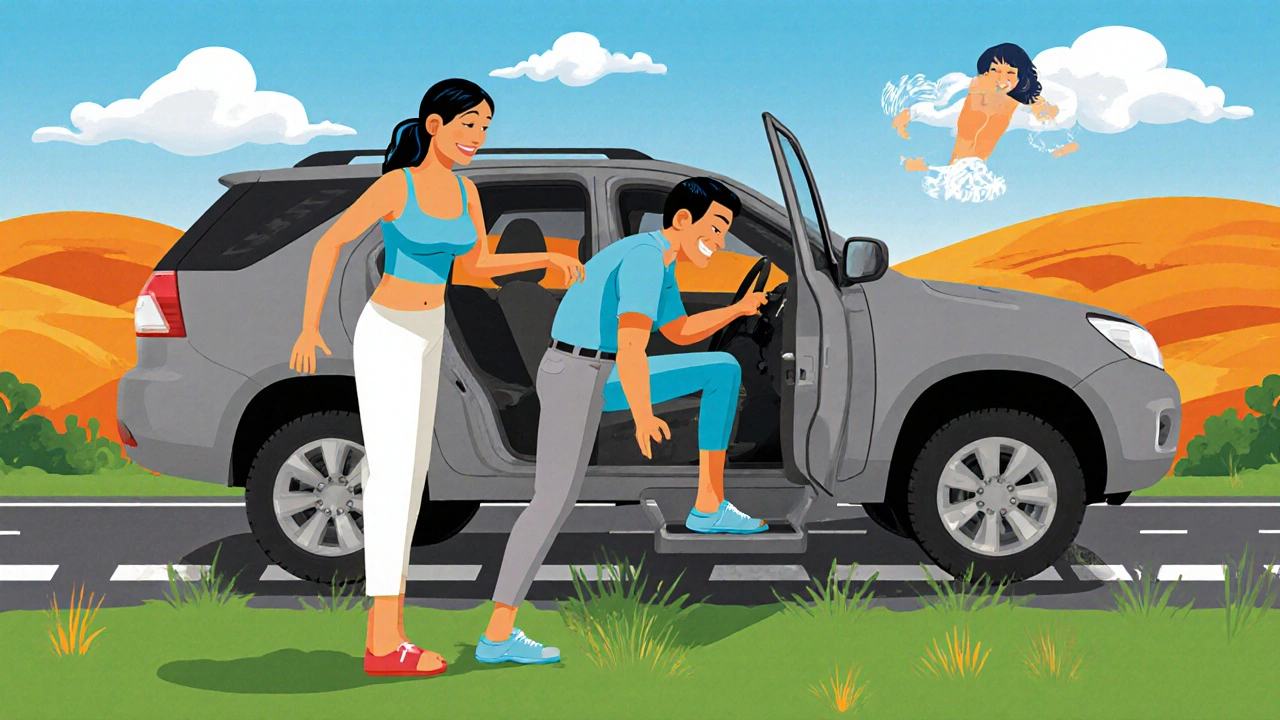Backache Prevention Seat Position Checker
Optimize Your Seat Position
Adjust these settings to reduce backache during long road trips
Results will appear here
When you spend hours behind the wheel, Backache is pain or discomfort in the spinal region caused by prolonged static posture, muscle fatigue, or improper support can quickly turn a road trip into a nightmare. The good news? A few simple adjustments and habits let you enjoy the scenery without the ache. Below you’ll find a step‑by‑step plan that fits any vehicle, from compact cars to full‑size SUVs.
Why Backache Happens on Long Drives
Even if you feel fine at the start, the lumbar spine is under constant compression once the seat backs up against a fixed surface. When the spine’s natural curve - the lordotic curve - flattens, the intervertebral discs lose a bit of their cushioning power. Add to that the fact that most car seats tilt the pelvis forward, tightening the hip flexors and pulling the lower back out of alignment. Over time the tiny muscles that support the spine fatigue, and that’s when that stabbing or dull ache appears.
Seat Position and Vehicle Ergonomics
Getting the seat right is the single most effective move you can make. Follow these tweaks before you even start the engine:
- Seat height: Raise the seat until your hips are at or slightly above knee level. This opens the hip angle and reduces strain on the core muscles.
- Backrest angle: Aim for a 100‑110° angle from the seat cushion to the backrest. Too upright forces the lumbar spine into a flat position; too reclined blurs the steering wheel view.
- Steering wheel distance: Your arms should have a slight bend at the elbows when you hold the wheel. Overreaching compresses the shoulders and forces the upper back to hunch.
- Seat belt placement: The lap belt must sit low on the hips, not the abdomen. A misplaced belt can push the pelvis forward and exacerbate lumbar pressure.
Many modern cars include an adjustable lumbar support knob or motorized pad. If yours does, set it so you feel a gentle swell of support in the small of your back - not a hard push.
Pre‑Drive Preparations
Spend five minutes before you leave to prime your body:
- Do a quick foam‑roller roll‑out on your upper back and glutes. This loosens tight fascial bands that often pull the spine out of alignment.
- Perform three sets of cat‑cow stretches (hands and knees on the floor, arching then rounding the back). This mobilises the entire spinal column.
- Activate your core with a 30‑second plank. A strong core acts like a natural lumbar brace.
Hydration matters, too. Aim for at least 500 ml of water before hitting the road - dehydration can make muscles cranky and more prone to spasm.

In‑Drive Stretch and Movement Routine
Even the best seat can’t replace movement. Plan a short break every 90‑120 minutes and try the following:
- Neck rolls: Slowly rotate your head clockwise three times, then counter‑clockwise. This relieves tension that often radiates down to the back.
- Seated spinal twist: While seated, place your right hand on the left armrest, look over the left shoulder, and hold for 15 seconds. Switch sides.
- Standing hamstring stretch: Pull one foot up onto the car step or a low wall, keep the leg straight, and lean forward gently. Hold 20 seconds each leg.
- Hip flexor stretch: Step out of the vehicle, place one foot forward, bend the front knee, and push the hips forward while keeping the back leg straight. Hold 20 seconds per side.
During the drive, keep your shoulders relaxed and periodically roll them backwards to counteract the natural forward slump.
Post‑Drive Recovery
When you finally pull into the garage, give your back a chance to reset:
- Lie on your back with a pillow under your knees for 5‑10 minutes. This relieves disc pressure.
- Do a gentle supine twist: bring one knee across the body, keep shoulders flat, and breathe deeply. Switch sides.
- Apply a warm compress or take a hot shower for 10 minutes to increase blood flow to sore muscles.
If you notice lingering stiffness, a short session of yoga or a light walk the next day helps clear any residual tension.

Best Gear and Accessories for a Pain‑Free Journey
Below is a quick comparison of the most effective products you can add to your car without breaking the bank.
| Product | Key Feature | Price (AUD) | Best For |
|---|---|---|---|
| Memory‑foam lumbar cushion | Conforms to spine curvature, adds 2‑inch lift | 45 | Drivers with flat‑back discomfort |
| Adjustable backrest strap | Secures cushion, allows tilt fine‑tuning | 30 | Vehicles without built‑in lumbar support |
| Portable footrest | Elevates feet, reduces hamstring pull | 25 | Long‑distance truck or van drivers |
| Ergonomic seat cover (gel) | Distributes weight, cools skin | 35 | Hot climates, summer road trips |
| Magnetic car massager | Provides gentle vibration to lumbar area | 60 | Those who need extra muscle relaxation |
Investing in a good lumbar cushion is the single most cost‑effective way to prevent backache on any trip. Pair it with a small footrest if you sit for more than three hours, and you’ll notice a dramatic drop in fatigue.
Key Takeaways
- Adjust seat height, backrest angle, and lumbar support before you drive.
- Warm‑up with core activation and spinal mobility drills.
- Take 5‑minute movement breaks every 1½‑2 hours.
- Use a memory‑foam lumbar cushion and, if needed, a portable footrest.
- Finish each trip with gentle stretching and a short period of supine rest.
Frequently Asked Questions
Can a regular car seat cause chronic back pain?
Yes. Seats that lack lumbar support and force you into a slouched posture can aggravate the lower back over time, especially if you drive more than a few hours per week.
How long should I stretch before a long drive?
A 5‑minute routine covering the cat‑cow, hamstring, and hip‑flexor stretches is enough to prime the spine and muscles.
Is it okay to use a pillow as a lumbar support?
A small, firm pillow can work in a pinch, but a purpose‑built lumbar cushion maintains its shape better and offers consistent support.
Should I take medication before a road trip?
Over‑the‑counter pain relievers may help if you already have mild discomfort, but they don’t replace good ergonomics. Talk to a doctor if you need regular medication.
What’s the best position for the steering wheel?
Hold the wheel at the 9‑ and 3‑o’clock positions with elbows slightly bent. This keeps the shoulders relaxed and reduces upper‑back strain.


Comments (10)
Angela Koulouris
Honestly, a quick seat‑adjustment can feel like a tiny miracle on a marathon drive. I love how moving the seat a few inches up instantly opens the hip angle and eases that nagging pressure. Adding a dash of lumbar support is like giving your spine a plush pillow‑kiss. Remember to keep the steering wheel within a comfy reach – it saves your shoulders from the dreaded hunch. A little pre‑drive stretch and you’re set for miles of smooth cruising.
Harry Bhullar
Alright, let’s break this down step by step because the devil is in the details and you don’t want a backache turning your scenic route into a nightmare. First off, the seat height: you want your hips at least level with your knees or a tad higher; this creates a neutral pelvic tilt and reduces lumbar compression. Next, the backrest angle: aim for roughly 100 to 110 degrees – anything steeper flattens the natural lordotic curve, anything shallower forces you to lean forward and overwork the upper back. The steering wheel distance is next; your elbows should be slightly bent, not locked, which prevents shoulder elevation and keeps the thoracic spine neutral. Don’t forget the lap belt – it should sit low on the hips, not on the abdomen, otherwise you’re pushing the pelvis forward and stressing the lumbar discs. If your car has an adjustable lumbar knob, set it so you feel a gentle swell, not a hard push, because a subtle lumbar pillow distributes pressure evenly across the intervertebral discs. Before you even start the engine, spend five minutes mobilising: foam‑roll your upper back and glutes, do three sets of cat‑cow to fluidify the spine, and finish with a 30‑second plank to fire up the core – think of the core as your built‑in lumbar brace. Hydration is also key; a de‑hydrated muscle is a cranky muscle, so gulp at least half a liter of water beforehand. During the drive, plan a 5‑minute micro‑break every 90‑120 minutes. Simple neck rolls, seated spinal twists, and standing hamstring stretches can reset your posture and restore blood flow. If you can step out, add a hip‑flexor stretch – it alleviates the anterior pelvic tilt that builds up from sitting. After you finally pull into the garage, lie on your back with a pillow under the knees for ten minutes to unload the discs, then do gentle supine twists and a warm shower to promote circulation. If you still feel a twinge the next day, a short yoga session or a leisurely walk will flush out residual tension. Finally, consider gear: a memory‑foam lumbar cushion adds a custom‑fit curve, a portable footrest lifts the legs and eases hamstring pull, and an ergonomic gel seat cover can keep you cool on hot days. All together, these tweaks form a holistic strategy that keeps your back happy, your posture strong, and your road‑trip memories vivid.
Dana Yonce
Got it, thanks for the quick tip! 👍
Lolita Gaela
Building on Harry's extensive breakdown, it's crucial to recognize the biomechanical interplay between the sacroiliac joint and the lumbar vertebrae during prolonged static postures. By employing a shear‑resistant memory‑foam lumbar module, you mitigate anterior shear forces that otherwise exacerbate intervertebral disc creep. Moreover, adjusting the lumbar knob to achieve an optimal I‑shaped support contour aligns the erector spinae muscle group, reducing myoelectric activation levels by up to 22% according to recent EMG studies. Don’t overlook the micro‑adjustment of the seat tilt angle; a 2‑degree rearward tilt can relieve posterior facet joint compression while preserving optimal pedal reach.
Giusto Madison
Look, I’m not here to sugarcoat it – if you keep slouching like a wilted lettuce, you’re asking for pain. Adjust that seat like you mean it, and stop pretending you don’t feel the strain. A decent lumbar cushion isn’t an extra; it’s a necessity if you value your back. And for the love of all things ergonomic, take those breaks every hour and move – the car isn’t a torture chamber.
Rachel Valderrama
Oh sure, because grabbing a coffee mid‑drive is the ultimate cure for spinal degeneration. 🙄
Chirag Muthoo
Dear fellow traveler, I wish to extend my heartfelt encouragement to adopt the aforementioned ergonomic practices. It is my sincere belief that adherence to these guidelines shall foster a harmonious journey, free from the lamentable afflictions of back discomfort. May your voyages be both safe and invigorating.
Jasmina Redzepovic
Listen, the American road culture thrives on efficiency, not on whining about a sore back. If you can’t afford a proper ergonomic seat, simply sit up straight and stop blaming the vehicle. The data is clear: poor posture equals lower productivity, and that’s unpatriotic. So invest in a lumbar brace or an actual seat upgrade, not just a cheap pillow that flattens after a few miles.
Eli Soler Caralt
Well, if we’re talking about the philosophy of motion, the car becomes a metaphysical chariot, transporting not only bodies but also the soul’s yearning for freedom. Yet, a sagging spine is like a broken lyre-harmonies lost. So, a sleek lumbar cushion? Absolutely necessary. 💺🚗✨ Remember, even the most enlightened traveler respects the corporeal vessel.
Eryn Wells
💡 Absolutely love the inclusive vibe here! No matter where you’re from, a proper seat setup benefits everyone. Let’s keep sharing these practical tips so all our fellow road‑trippers stay comfy and safe. 🌍🚙🙂